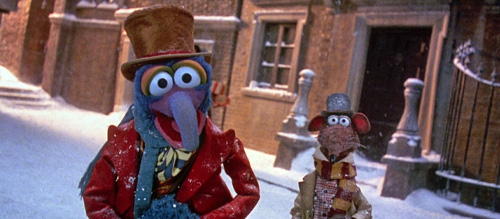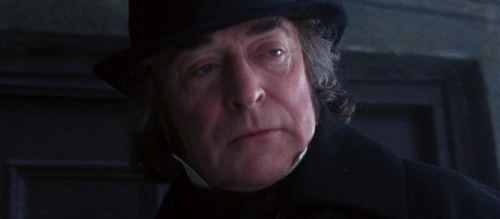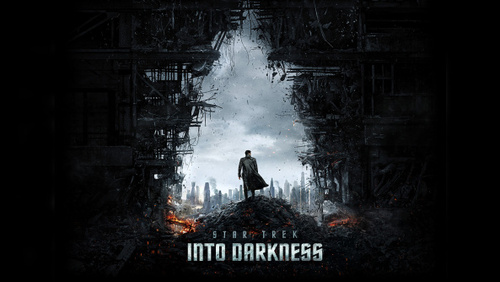Gonzo and Rizzo being one of the main sources of the film’s comedy illustrates the intuitive casting of The Muppet Christmas Carol: human and Muppet. This is the first of the Muppets’ feature length movies in which the fuzzy puppets aren’t the narrative focus of the plot; the movie is more akin to ‘The Muppet Show’ in which the Muppets are the talented ensemble supporting the human guest star, and here they are used to their full potential. Many of the beloved Muppet characters have quite a short appearance (as many original puppets were necessary for the telling of this particular story), but they make their impact instantly, i.e Fozzie Bear’s simplistic optimism and Sam Eagle’s austere air (and his continuing American Patriotism even when trapped in a British novella).
Kermit the Frog has not only been the long-time straight man of the gang, but has also been the heart of most of the Muppet productions. The Muppet Christmas Carol is no exception. Here, our little green friend is cast in the role of Bob Cratchit, Ebenezer Scrooge’s underpaid clerk. If the magic of this film is to be summarised by one screen capture, it would be that of Bob Cratchit singing the last few notes of “One More Sleep ’til Christmas” whilst watching a shooting star fly past in the wintry cityscape. It is Kermit as Bob that steers the plot through its most poignant and saddest moments, soothing his family with wisdom relevant to those experiencing grief in real life.

It is this sincere performance by Sir Michael Caine that carries most of the emotional weight of the movie and elevates Caine himself above other on-screen depictions of Scrooge. Many an actor’s version of Scrooge has been frozen into a curmudgeonly glower, particularly those offered by Albert Finney and Jim Carrey. In stark contrast, Michael Caine’s Scrooge is boasting the entire range, from cool derision to fiery rage and even a touch of gleeful sadism. Furthermore, his Scrooge lacks the initial twinkle in his eye that has often been employed in other adaptations, including Bill Murray’s and Kelsey Grammer’s; instead Caine employs the use of his iconic cold stare, the likes of which made him an unmissable movie star in violent films throughout the 70s and 80s, such as Get Carter. Michael Caine’s Scrooge is not only formidable but genuinely quite frightening, and therefore the progression of his character’s arc proves to be quite the wild ride as Caine’s performance through Scrooge’s tragedies and regrets is nothing short of incredibly moving. As Tiny Tim leads the Cratchit family in a round of “Bless Us All”, we melt as Scrooge melts; we see him fill up with guilt, regret, and even love and fondness – it’s etched all over his face. Scrooge’s redemption is not a case of us finding out what we knew all along, that Scrooge was a decent man deep down – Caine’s Scrooge is an actual transformation that had to win our sympathy through his moving experiences.
Thus it proves to be extremely frustrating that one of the most poignant scenes that provides significant backstory as to why Scrooge had become so cold is cut from the film. Meredith Braun as Scrooge’s fiancée Belle sings “When Love is Gone” when she ends her engagement with the young Scrooge as Caine looks on and shakily joins in with the last verse only to break down in tears. This scene was cut in the original theatrical release as Disney had thought it was too upsetting to younger audiences. It was subsequently included in the VHS version but was again excluded for the DVD, Blu Ray, television and streaming releases, much to the protest and dismay of those who grew up with the VHS version (especially at the news that the original master recording may have been lost, and especially as its exclusion leaves a jarring cut). Brian Henson revealed in 2020 that this version had been located and that the scene was hopefully going to be added back into later editions.
Ultimately, the cutting of this scene represents a lack of vision from Disney and supports their current reputation for preferring the least offensive and most lazy filmmaking, often coasting on the creativity of other innovators like Jim Henson, Stan Lee and George Lucas. When thoroughly examining the production choices of The Muppet Christmas Carol, it quickly becomes apparent that such powerful storytelling could never come from a boardroom, Disney or otherwise. The film’s message is not merely a reminder of being kind and generous during Christmas, it promotes the transforming power of kindness and preaches that the unfair hoarding of wealth is immoral, evil. Scrooge’s death in the Ghost of Christmas Yet to Come’s vision is portrayed as brining joy to the townsfolk; the song “Marley and Marley” explicitly states Scrooge’s late partner’s greed as the cause of their damned afterlife (doomed to drag around heavy chains for all eternity). It really is a song many of us would want some of the current world leaders and public figures to sit down and listen to.
As such, the creative team behind The Muppet Christmas Carol have become a part of the rallying cry that has continued for well over a century since Dickens’ death. It is a film in defence of the vulnerable in society and denounces the greed of the super-rich. This is something that the tax dodging and anti-LGBTQ+ lobbying suits of the Walt Disney Company could never meaningfully achieve.
Score: 22/24



